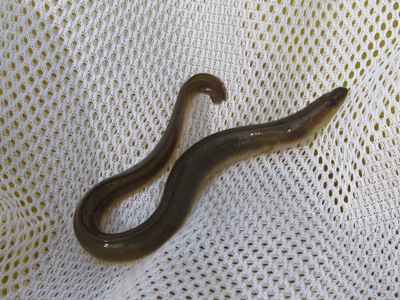The American eel is an effective but often misunderstood bait for saltwater fishing. Eels are covered with a heavy coating of slime which is makes them difficult to rig and fish with. Despite their challenges, eels are a top bait for catching such trophy species as striped bass, cobia, and bluefish.
Eels are usually hooked thru the lips or eye sockets and fished on a Carolina style leader, without weight or with an egg sinker above the leader. Anglers use circle or live bait hooks, depending on regulations and personal preference.
Live eels are usually allowed to drift along rips, drop offs, or channel edges where large fish tend to congregate. In the Chesapeake Bay and along the Virginia coast, they are popular for sight casting to cobia.
Live eels are available at many tackle shops in Tidewater Virginia. Bait sized eels are occasionally caught by saltwater and river anglers. They are found around bridges, pier and other structures, especially at night.
A few specialized techniques are used for transporting and using live eels for fishing. Live eels can be kept for limited periods in a livewell with aeration or recirculating water.
In many cases, they can be kept successfully by placing them in a container above a layer of ice and wet newspapers. When transported in this manner, its important that the eels not be submerged in water, as they will expire quickly. The bait container should be stored in a larger cooler with ice to stay chilled.
Handling and rigging eels can be a challenge. Some anglers prefer textured gloves when handling eels. Others carry a small bucket of sand to dip eels in when rigging. The sand coating provides a temporary barrier against the eel’s slime coating.
After an eel is rigged, care must be taken when casting or drifting the bait. Live eels will swim erratically and can cause tangles and other mishaps.
Related Information
